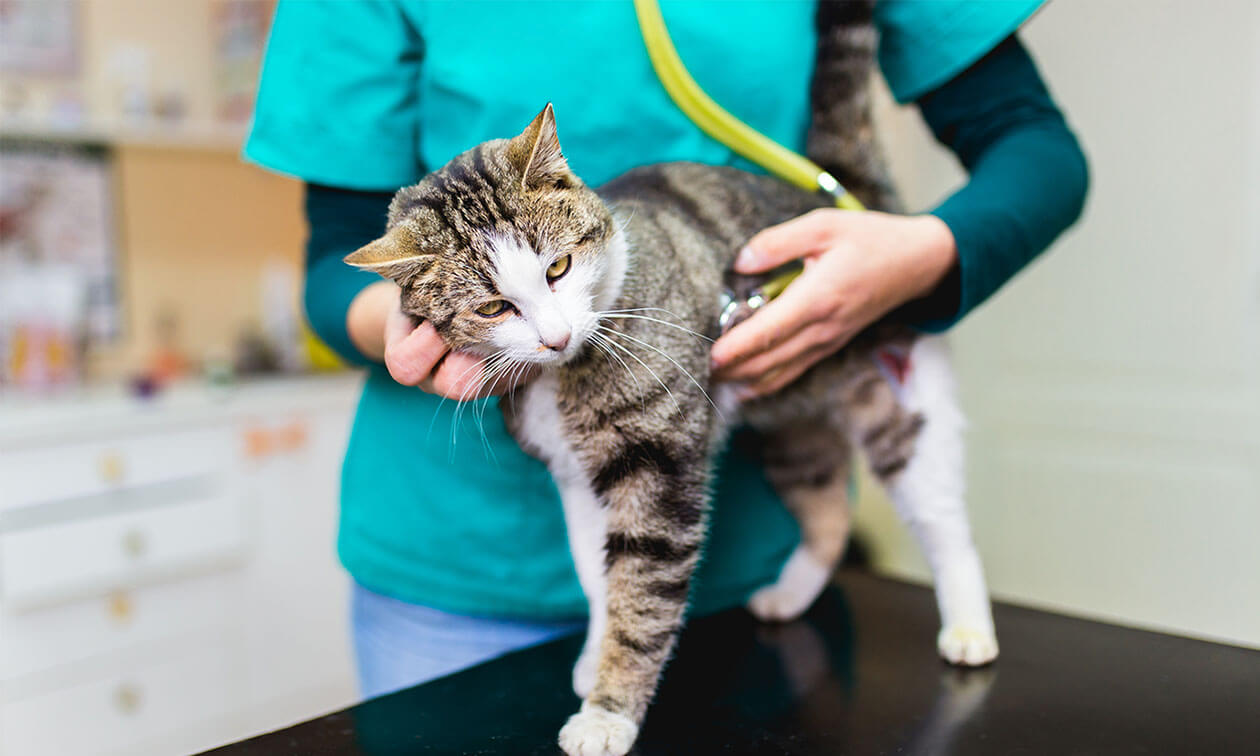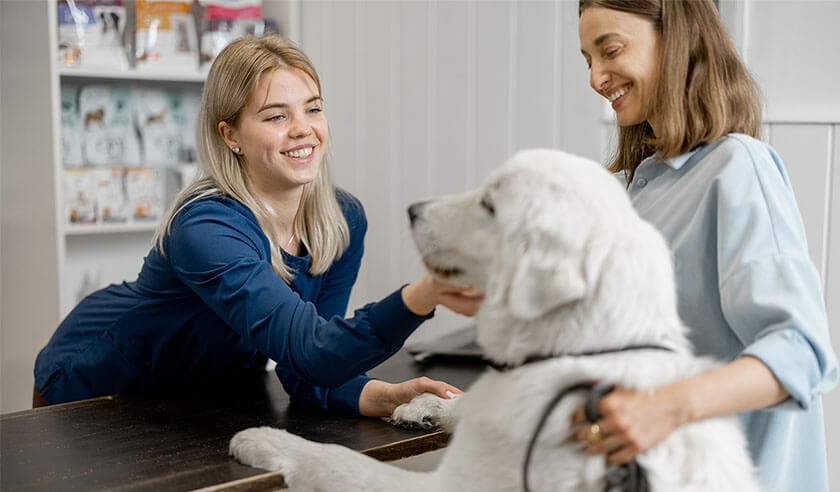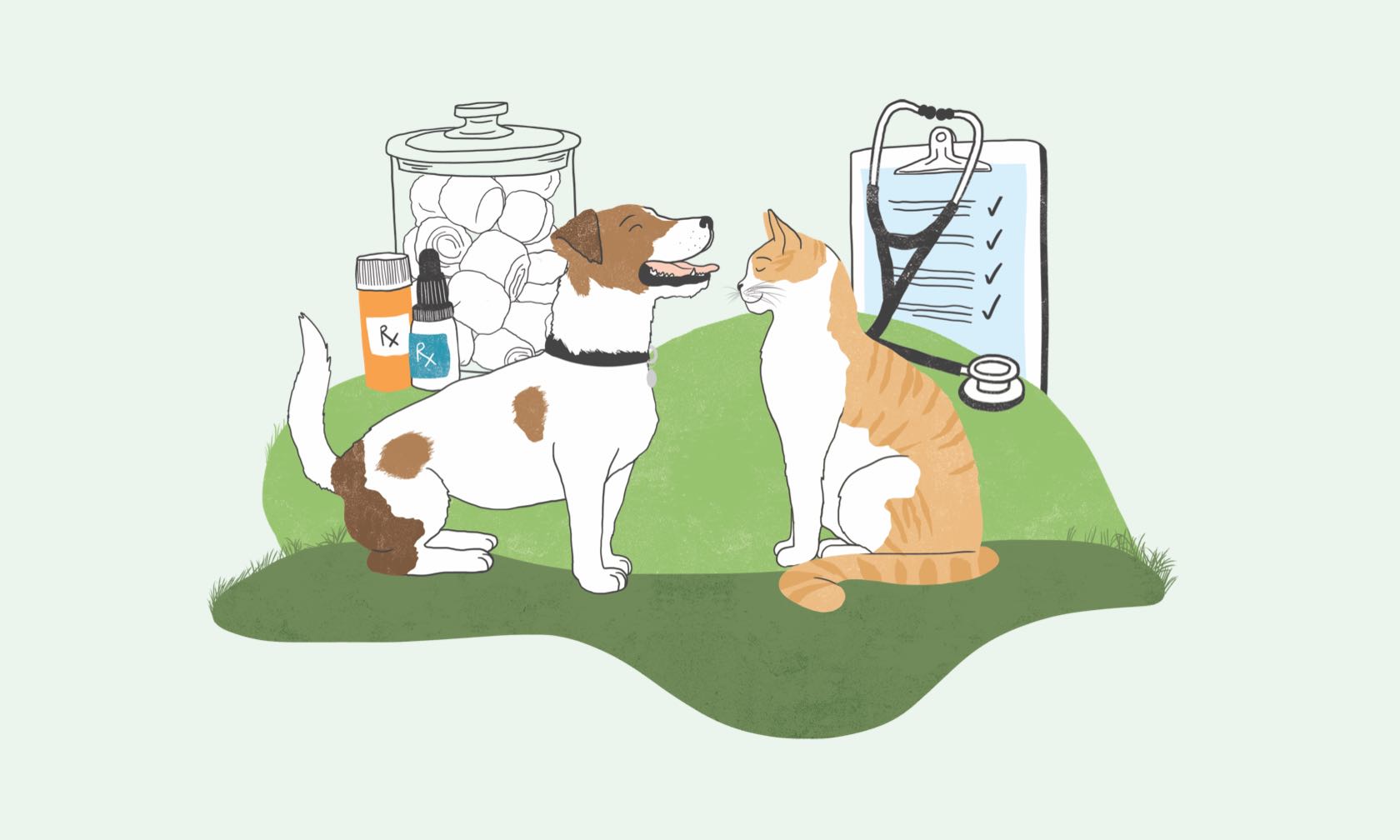Many cats don’t get regular veterinary care because we are so concerned about the stress and fear they feel in the process. Did you know that cats are one of the most popular pets in the United States but visit the vet less frequently than dogs1? Of the estimated 61 million household cats, 60% do not visit the vet on a routine basis2. Cats are also good at hiding their illnesses from us, and knowing your cat may experience stress when transporting them to the vet, can often give you stress, as well – which could be some of the reasons preventing more regular check-ups3.
For a cat, it can be a terrifying experience to go to a strange place with strange people, loud sounds, and scary smells. To lessen the trauma of a stressful experience, you may put off annual visits which puts your cat at health risks since they need routine vet care.
So, what can you do? You want your cat to have the best experience possible at the veterinarian with the least stress. Finding a cat-friendly veterinary practice is one of the best ways.
There are different types of cat-friendly clinics — those that are certified and those that may not be certified but do put special practices in place to work with cats in the least stressful way possible.
What Are the Benefits of a Cat-Friendly Veterinary Practice?
A cat-friendly practice benefits not just your cat, but also you and the veterinary team. It’s important to remember that even an extremely aggressive cat is usually acting out of fear, not anger. It’s their instinct to protect themselves, and from your cat’s perspective, everything that happens at a veterinary clinic can feel like it’s meant to do harm. Cats either fight, run, or freeze as a means of protection. So even a cat that is sitting quietly may be afraid but will show their stress by freezing rather than acting aggressively.
It sounds obvious, but it’s important to remember that cats are not small dogs. They are unique in their needs and reactions to things, which is why they need to be treated differently in veterinary clinics. This is where the specialized training and care-giving techniques learned in cat-specific certification and education programs comes in. In a cat-friendly practice, you may see things like:
- Cat-only areas where dogs and other pets are not allowed, including the waiting area and exam room. Seeing, hearing, and smelling dogs can be frightening for a cat.
- Exam rooms designed with high space, hiding spots, heated tables or pads and towels on the table and other elements to make cats feel safe and welcomed.
- A variety of treats and toys used throughout the visit to keep it positive for the cat.
- Use of things that help reduce cat fear, anxiety, and stress such as calming or pheromone sprays.
- Lowered voices and noise, making the exam and treatment areas less stimulating and overwhelming (or cat friendly mew-sic designed specifically for cats).
- Avoiding use of scruffing techniques, restraining garments, gloves, or tools that remove the cat’s choice and control.
- Performing the exam slowly and gently where the cat is most comfortable (like in their carrier, with the top removed).
- Limiting testing and treatment to what is necessary, critical, and in order of importance to avoid things that may cause fear, anxiety, and stress until the cat can be positively desensitized to those things. Or they can be prescribed a medication to help with anxiety and fear.
Here are some of the benefits of using a cat-friendly veterinary practice:
- Cats experience less stress and fear. It only takes one negative experience for a cat to learn, “That is scary. I need to protect myself.” That means the distress they experience can actually worsen over time.
- You experience less stress. Seeing our pets in distress is upsetting, even when we know it’s for a good reason.
- You’re likely to have a better experience. In addition to lowering your stress level, you’re going to feel more comfortable taking the time to talk with your vet instead of rushing to get your cat home. Also, the care your cat receives may even be better.
- Your cat may get better care. A comfortable cat is easier to examine and diagnose which is important when we only have a yearly touchpoint. Being able to have a thorough exam of all body systems helps identify any health concerns early on. For example, seeing a cat’s facial expression and body language the exam is performed can help diagnose a problem. A scared or stressed cat isn’t going to respond naturally to this kind of handling, making it hard to diagnose their pain pinpoint a potential problem. They will also be more cooperative during the tests, like annual blood work your vet team needs to perform. The veterinary team has been trained and has increased knowledge about handling techniques and caring for a cat’s unique health and behavioral needs.
- The veterinary team is safer. Cats know how to defend themselves when they feel they’re in danger. This puts team members and even you at risk for injury-like bites or scratches if you handle them when they’re scared – it’s an instinctual reaction. If the cat is more relaxed and less fearful, they will be more open to the vet handling them with less restraint, keeping everyone safe and sound during the visit.
Certified Veterinary Practices
Veterinary clinics can be accredited through the Cat Friendly Certificate Program. This certification was created to expand upon the Cat Friendly Practice Program developed by the American Association of Feline Practitioners (AAFP) and the International Society for Feline Medicine (ISFM). It’s intended to make veterinary care less stressful for cats, cat parents, and the entire veterinary team by improving the clinic environment and experience.
To achieve accreditation as a Cat Friendly Clinic, there are significant criteria that the team and facility must meet, and the work is not over once the practice is accredited. To maintain their accreditation, they must:
- Continue team development and learning with cat-specific courses yearly.
- Allow monitoring to ensure the clinic continues to provide an environment that is stress-free and well-equipped to care for cats.
- Allow clinical records to be monitored and evaluated.
Fear Free Certified Veterinary Practices
Fear Free is an online educational program for veterinary professionals and others in pet-focused professions. While the program is not 100% cat-focused, the principles and techniques support the idea of a fear-free, cat-friendly practice. As part of the certification program, participants take a pledge to, in part:
- Hold a pet’s emotional and physical wellbeing in mind at all times
- Recognize subtle signs of fear, anxiety, and stress (FAS)
- Use gentle control, touch gradient, and other techniques to prevent FAS
- Promote the Fear Free approach as a whole-lifestyle approach from the home, to the car, to the veterinary clinic
- Support pet owners in preventing and relieving FAS in all aspects of their pet’s life
What To Do When You Can’t Find a Cat-Friendly Veterinary Practice
If your area doesn’t have a cat-friendly certified clinic or a clinic committed to lower-stress feline handling, there are still ways you can minimize your cat’s stress. These steps start before you even need to schedule a veterinary visit and go right through to the end of your appointment. If you’re having a hard time helping your cat get comfortable with vet visits or have an emergency where you don’t have the time to do upfront desensitization work before the visit, talk to your veterinarian about a pre-visit prescription medication that can help reduce your cat’s fear, anxiety, and stress. These medications are prescribed and intended to be given before leaving your home that can help alleviate fear, anxiety, and stress and maximize their vet visit journey. These can be especially helpful if your cat had negative veterinary experiences in the past or is generally fearful.
Routine vet visits are essential to keeping your cat well throughout their life. So, advocate for your cat and partner with your vet health team, and you’ll to create a paw-sitive vet visit for your cat.
ZPC-03271R1
IMPORTANT SAFETY INFORMATION: Not for human use. Do not use in cats with known hypersensitivity to pregabalin. Use with caution in cats with cardiac disease, hypertension, renal disease, or severe systemic disorders. The safe use of BONQAT has not been evaluated in breeding, pregnant, or lactating cats; in cats younger than 7 months of age; in cats with cardiac disease, hypertension, renal disease, or severe systemic disorders; or in conjunction with opioids and other sedatives. The most common side effects are incoordination, lethargy, and vomiting. See Prescribing Information.
Bonqat® is a registered trademark of Orion Corporation. It is manufactured by Orion Corporation and distributed in the United States by Zoetis under license from Orion Corporation. All trademarks are the property of Zoetis Services LLC or a related company unless otherwise noted. ©Zoetis Services LLC. All rights reserved.
- U.S. Pet Ownership & Demographics Sourcebook. AMVA. https://ebusiness.avma.org/files/ProductDownloads/eco-pet-demographic-report-22-low-res.pdf. Accessed February 15, 2024.
- PetTrak US FTH National February 2022. ZMR. Accessed February 15, 2024.
- KGMarketsense November Pet Owner Quantitative Research July 2018. ZMR. Accessed February 15, 2024.






